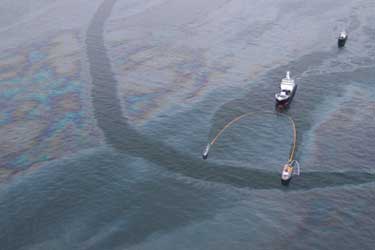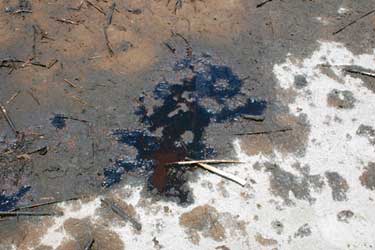Oil Spill Dispersants
Objectives & Background

Photo credit: NOAA Photo Library.
A genetically modified strain of a common bacterium, Bacillus subtilis, will be used in the initial research. The scientists believe that modifications to the bacterium, using various fermentation energy sources or genetic modifications, can produce a by-product that will effectively disperse oil without the unwanted impacts to the ecosystem that might occur with traditional dispersants.
Four low-value agricultural feedstocks – bagasse, soy hulls, soy fibers and crude glycerol – will be used in the study to grow two hybrid strains of Bacillus subtiliswith the objective of producing higher yields of biosurfactants and isoforms (dispersants) through green chemistry principles. The researchers anticipate that these by-products will be less toxic and have greater biodegradability compared to Corexit, the synthetic surfactant used during the 2010 BP oil spill in the Gulf of Mexico. Corexit is effective; however it has moderate toxicity, according to the EPA and other groups.
The possible toxicity the researchers’ green dispersant formulas will be evaluated using juvenile and larval Gulf killifish (Fundulus grandis).
Additionally, the team will conduct community outreach activities to illustrate the relative toxicity of crude oil, a synthetic dispersant used commonly today, a common detergent and naturally dispersed crude oils. The demonstrations will be conducted in communities affected by the 2010 oil spill. Published manuscripts will disseminate results to scientific community, and factsheets will be published for the overall public.
Detail Rational and Background for the Research
 The need for green and non-toxic dispersants for oil spill remediation is growing. The synthetic dispersants, Corexit EC 9500A and Corexit EC 9527A, are effective in dispersing oil spills; however, the toxicity of these dispersants (LC50 of ~2.62 ppm) and that of resulting dispersed oil (LC50 of 317.7 ppm) is a major setback for their use in oil spills. Corexit is a mixture of propylene glycol, dioctyl sodium sulfosuccinate and 2-butoxyethanol. Besides causing liver cancer in animals, 2-butoxyethanol was also associated with health problems of cleanup workers at the 1989 Exxon Valdez Alaskan oil spill. Due to the environmental and health risks from the synthetic dispersants, dispersants from biological sources are favored for their biodegradability and low toxicity.
The need for green and non-toxic dispersants for oil spill remediation is growing. The synthetic dispersants, Corexit EC 9500A and Corexit EC 9527A, are effective in dispersing oil spills; however, the toxicity of these dispersants (LC50 of ~2.62 ppm) and that of resulting dispersed oil (LC50 of 317.7 ppm) is a major setback for their use in oil spills. Corexit is a mixture of propylene glycol, dioctyl sodium sulfosuccinate and 2-butoxyethanol. Besides causing liver cancer in animals, 2-butoxyethanol was also associated with health problems of cleanup workers at the 1989 Exxon Valdez Alaskan oil spill. Due to the environmental and health risks from the synthetic dispersants, dispersants from biological sources are favored for their biodegradability and low toxicity.
The selection of a dispersant in oil spill dispersion is influenced by its efficacy and environmental impact. The development of more effective biodispersants using green chemistry, and processing principles focuses on shortening environmental half-lives and reducing their toxicity to marine and freshwater biota. Economic production of biodispersants from low cost feedstocks with the efficient green recovery methods will improve their acceptability, augment their use and reduce or eliminate the need for synthetic dispersants. Identification and characterization of effective, environmentally friendly and low-cost biodispersants is of criticalimportance.
Surfactin is a powerful biodispersant produced by Bacillus subtilis. It is a lipopeptide and consists of fatty acid chains of 12-17 carbons linked to the seven amino acids. Surfactin is well known for its ability to reduce the surface tension of water. However, its insufficient solubility in water greatly reduces its efficacy for use in oil-spill dispersion at sea. Modular Genetics Inc. (Modular), one of the team’s research collaborators, genetically engineered Bacillus subtilis to produce a highly water soluble variant of the biosurfactant. It was named FA-Glu, which is shown to be more effective, biodegradable and less toxic by project research collaborators. FA-Glu consists of fatty acid chains of 12-17 carbons linked to a Glutamic acid by peptide bond. Its higher surface-activity and solubility in salt- and fresh water than surfactin are of advantage for its use as oil spill dispersant.
The environmental impacts of FA-Glu are still being evaluated; however, they are expected to be lower than chemical dispersants currently in use. Due to the variability of the fatty acid chains associated, FA-Glu is not one unique molecule, but a mixture of species (isoforms) with different molecular weights. Since there is a critical need to develop an effective dispersant for oil spill dispersion and to characterize its environmental effects, selection of FA-Glu and its species for this purpose is logical. The genetics of the source microorganism, Bacillus subtilis is well known and, its structure and biochemical properties can be modified. Moreover, production parameters and fermentation feedstock composition also affect its surface-active properties.
The long-term goal is to expand science-based knowledge in developing greenbiodispersants that will have higher surface-active properties, lower toxicity, and higher biodegradability. Producing biodispersants utilizing low-value feedstocks will be one step towards this goal. The objective in this project is to produce, and recover biodispersant(s),especially FA-Glu, using a genetically-modified strain of Bacillus subtilis on different biological feedstocks with green chemistry and to evaluate their dispersion efficacy, toxicity and biodegradability compared to chemical dispersant, Corexit. The FA-Glu will also be fractionated into six isoforms based on their chemical structure and characterized. The central hypothesis is that structural differences in isoforms of the biodispersants influence it properties, and such differences could be brought about by fermentation conditions.
The rational for these studies is that successful production of FA-Glu isoforms andevaluation of their dispersion properties could result in their use in oil spill remediation with lower environmental impact. The knowledge of toxicity, effectiveness and yield for the isoforms will provide us with opportunity to utilize local agricultural feedstocks to produce biodispersants for use in oil spills, and other uses, for example, in cosmetics, food, and agriculture. The data obtained in this study will potentially lead researchers to develop fixed chain length FA-Glu viagenetic modification.
